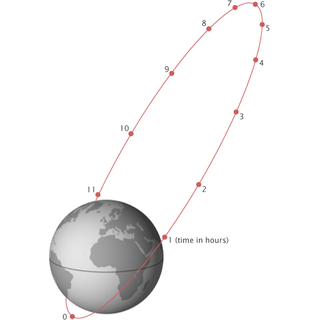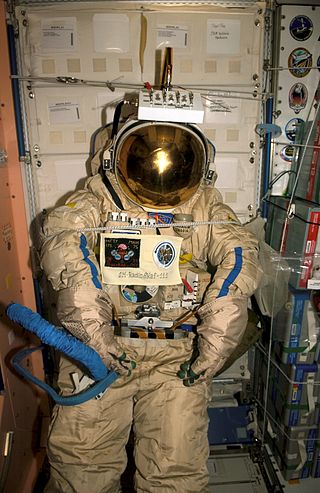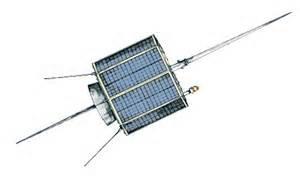
The Global Positioning System (GPS), originally Navstar GPS, is a satellite-based radio navigation system owned by the United States government and operated by the United States Space Force. It is one of the global navigation satellite systems (GNSS) that provide geolocation and time information to a GPS receiver anywhere on or near the Earth where there is an unobstructed line of sight to four or more GPS satellites. It does not require the user to transmit any data, and operates independently of any telephone or Internet reception, though these technologies can enhance the usefulness of the GPS positioning information. It provides critical positioning capabilities to military, civil, and commercial users around the world. Although the United States government created, controls and maintains the GPS system, it is freely accessible to anyone with a GPS receiver.
AMSAT is a name for various amateur radio satellite organizations worldwide. In particular, it often refers to the Radio Amateur Satellite Corporation, headquartered in Washington, D.C. AMSAT organizations design, build, arrange launches for, and then operate (command) satellites carrying amateur radio payloads, including the OSCAR series of satellites. Other informally affiliated national organizations exist, such as AMSAT Germany (AMSAT-DL) and AMSAT Japan (JAMSAT).
AMSAT-OSCAR-40, also known as AO-40 or simply OSCAR 40, was the on-orbit designation of an amateur radio satellite of the OSCAR series. Prior to launch, the spacecraft was known as Phase 3D or "P3D". AO-40 was built by AMSAT.
UoSAT-2, which is also known as UO-11 and OSCAR-11, is a British satellite orbiting in Low Earth Orbit. The satellite functions as an amateur radio transmitter and was built at the University of Surrey. It launched into orbit in March 1984 and remains orbital and active, though unstable with irregular periods of transmission. All of the analogue telemetry channels failed in 2005, but as of 2014 the status channels were still operational. The satellite was still heard transmitting telemetry in 2023, thirty-nine years after launch.

A Molniya orbit is a type of satellite orbit designed to provide communications and remote sensing coverage over high latitudes. It is a highly elliptical orbit with an inclination of 63.4 degrees, an argument of perigee of 270 degrees, and an orbital period of approximately half a sidereal day. The name comes from the Molniya satellites, a series of Soviet/Russian civilian and military communications satellites which have used this type of orbit since the mid-1960s. A variation on the Molniya orbit is the so-called Three Apogee (TAP) orbit, whose period is a third of a sidereal day.

A military satellite is an artificial satellite used for a military purpose. The most common missions are intelligence gathering, navigation and military communications.

AMSAT-OSCAR 51 or AO-51 is the in-orbit name designation of a now defunct LEO amateur radio satellite of the OSCAR series; formerly known as ECHO, built by AMSAT. It was launched on June 29, 2004 from Baikonur Cosmodrome, Kazakhstan on a Dnepr launch vehicle. It is in Sun synchronous low Earth orbit.

A satellite navigation or satnav system is a system that uses satellites to provide autonomous geopositioning. A satellite navigation system with global coverage is termed global navigation satellite system (GNSS). As of 2024, four global systems are operational: the United States's Global Positioning System (GPS), Russia's Global Navigation Satellite System (GLONASS), China's BeiDou Navigation Satellite System (BDS), and the European Union's Galileo.

SuitSat was a retired Russian Orlan space suit with a radio transmitter mounted on its helmet, used as a hand-launched satellite.
SumbandilaSat, was a South African micro Earth observation satellite, launched on 17 September 2009 on a Soyuz-2 launch vehicle from the Baikonur Cosmodrome. The first part of the name, Sumbandila, is from the Venda language and means "lead the way".
TiungSAT-1 is the first Malaysian microsatellite. The satellite is developed through the technology transfer and training programme between Astronautic Technology Sdn Bhd (ATSB) Malaysia and Surrey Satellite Technology Ltd., United Kingdom. TiungSAT-1 was launched aboard Dnepr rocket from Baikonur Cosmodrome, Kazakhstan on 26 September 2000.
UoSAT-1, also known as UoSAT-OSCAR 9 (UO-9), was a British amateur radio satellite which orbited Earth. It was built at the University of Surrey and launched into low Earth orbit on 6 October 1981. It exceeded its anticipated two-year orbital lifespan by six years, having received signals on 13 October 1989, before re-entering the atmosphere.

AMSAT-OSCAR 7, or AO-7, is the second Phase 2 amateur radio satellite constructed by the Radio Amateur Satellite Corporation (AMSAT). It was launched into Low Earth Orbit on November 15, 1974 and remained operational until a battery failure in 1981. After 21 years of apparent silence, the satellite was heard again on June 21, 2002 – 27 years after launch. At that time the public learned that the satellite had remained intermittently functional and was used surreptitiously for communication by the anticommunist opposition Fighting Solidarity during martial law in Poland.
AMSAT-OSCAR 16, also known as AO-16 and PACSAT, is the in-orbit name designation of an amateur radio satellite of the OSCAR series. It was built by AMSAT and was launched on 22 January 1990 from Kourou, French Guiana on an Ariane 4 launch vehicle. It is in Sun synchronous low Earth orbit.
Sputnik 40, also known as Sputnik Jr, PS-2 and Radio Sputnik 17 (RS-17), was a Franco-Russian amateur radio satellite which was launched in 1997 to commemorate the fortieth anniversary of the launch of Sputnik 1, the world's first artificial satellite. A 4-kilogram (8.8 lb) one-third scale model of Sputnik 1, Sputnik 40 was deployed from the Mir space station on 3 November 1997. Built by students, the spacecraft was constructed at the Polytechnic Laboratory of Nalchik in Kabardino-Balkaria, whilst its transmitter was assembled by Jules Reydellet College in Réunion with technical support from AMSAT-France.
An amateur radio satellite is an artificial satellite built and used by amateur radio operators. It forms part of the Amateur-satellite service. These satellites use amateur radio frequency allocations to facilitate communication between amateur radio stations.

OSCAR 3 is the third amateur radio satellite launched by Project OSCAR into Low Earth Orbit. OSCAR 3 was launched March 9, 1965 by a Thor-DM21 Agena D launcher from Vandenberg Air Force Base, Lompoc, California. The satellite, massing 15 kg (33 lb), was launched piggyback with seven United States Air Force satellites. Though the satellite's active life was limited to sixteen days due to battery failure, OSCAR 3 relayed 176 messages from 98 stations in North America and Europe during its 274 orbit life-time -- the first amateur satellite to relay signals from Earth. As of 2023, it is still in orbit.

OSCAR IV was the fourth amateur radio satellite launched by Project OSCAR and the first targeted for Geostationary orbit on 12 December 1965. The satellite was launched piggyback with three United States Air Force satellites on a Titan IIIC launch vehicle. Due to a booster failure, OSCAR 4 was placed in an unplanned and largely unusable Geostationary transfer orbit.

AMSAT OSCAR 10 was a star-shaped German AMSAT micro-satellite. It was launched on 16 June 1983 from Guiana Space Centre, Kourou, French Guiana, with an Ariane 1 rocket. This was changed to a Molniya orbit using an attached booster, to support world-wide amateur satellite communications.
Fox-1E, AO-109 or AMSAT OSCAR 109 is an American amateur radio satellite. It is a 1U Cubesat, was built by the AMSAT-NA and carries a 30KHz linear transponder radio. Fox-1E is the fifth amateur radio satellite of the Fox series of AMSAT North America.









